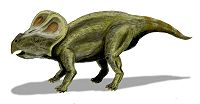- Minhe Formation
-
Minhe Formation
Stratigraphic range: Campanian to Maastrichtian[1]Type Geological formation Location Region Asia The Minhe Formation (simplified Chinese: 民和组; traditional Chinese: 民和組; pinyin: Mínhé Zǔ) is a geological formation in northwestern China, whose strata date back to the Late Cretaceous period.
Dinosaur remains are among the fossils that have been recovered from the formation.[2]
Contents
Vertebrate paleofauna
Dinosaurs
A tyrannosaur tooth with a split carina has been recovered from the Minhe Formation in China.[3]
Color key
Taxon Reclassified taxon Taxon falsely reported as present Discredited taxon Ichnotaxon Ootaxon Morphotaxon Notes
Uncertain or tentative data are in small text;crossed outdata are discredited.Dinosaurs reported from the Minhe Formation Genus Species Location Stratigraphic position Material Notes Images H. pachycephalus[1]
- Gansu[1]
"Badly preserved cranial and postcranial fragments."[4]
Microceratops[1]
M. gobiensis[1]
- Gansu[1]
"Teeth, fragmentary jaws and postcrania."[5]
M. sulcidens[1]
- Gansu[1]
"Tooth."[5]
P. philemys[1]
- Gansu[1]
"Very fragmentary jaw with [one] tooth."[6]
P. andrewsi[7]
T. bexelli[8]
- Inner Mongolia[8]
V. mongoliensis[9]
- Inner Mongolia[8]
See also
Footnotes
- ^ a b c d e f g h i j k l m "3.3 Gansu, People's Republic of China; 1. Minhe Formation," in Weishampel, et al. (2004). Page 598.
- ^ Weishampel, David B; et al. (2004). "Dinosaur distribution (Late Cretaceous, Asia)." In: Weishampel, David B.; Dodson, Peter; and Osmólska, Halszka (eds.): The Dinosauria, 2nd, Berkeley: University of California Press. Pp. 593-600. ISBN 0-520-24209-2.
- ^ "Tyrannosauridae," in Molnar (2001); page 347.
- ^ "Table 21.1," in Weishampel, et al. (2004). Page 466.
- ^ a b "Table 22.1," in Weishampel, et al. (2004). Page 480.
- ^ "Table 17.1," in Weishampel, et al. (2004). Page 368.
- ^ a b "3.3 Gansu, People's Republic of China; 1. Minhe Formation" and "3.3 Nei Mongol Zizhiqu, People's Republic of China; 3. Minhe Formation," in Weishampel, et al. (2004). Pages 598-599.
- ^ a b c d e "3.3 Nei Mongol Zizhiqu, People's Republic of China; 3. Minhe Formation," in Weishampel, et al. (2004). Pages 598-599.
- ^ a b Listed as "cf. Velociraptor mongoliensis" in "3.3 Nei Mongol Zizhiqu, People's Republic of China; 3. Minhe Formation," in Weishampel, et al. (2004). Pages 598-599.
References
- Molnar, R. E., 2001, Theropod paleopathology: a literature survey: In: Mesozoic Vertebrate Life, edited by Tanke, D. H., and Carpenter, K., Indiana University Press, p. 337-363.
- Weishampel, David B.; Dodson, Peter; and Osmólska, Halszka (eds.): The Dinosauria, 2nd, Berkeley: University of California Press. 861 pp. ISBN 0-520-24209-2.
Categories:- Cretaceous geologic formations
- Paleontological site stubs
- People's Republic of China geography stubs
Wikimedia Foundation. 2010.

